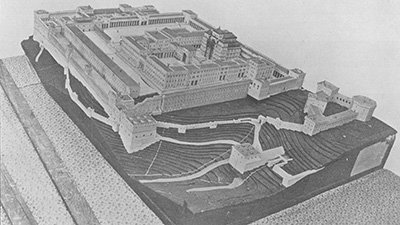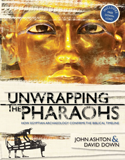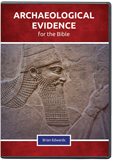
Evidence for the Seven Year Famine of Joseph’s Time Found?
Was a “mega-drought” from 4,200 years ago actually the cause of the famine in Joseph’s day?
A recent Nature article posed the question, “Did a mega drought topple empires 4,200 years ago?”1 Although the date does not line up with biblical timelines, as there are problems with radiometric dating methods that have been discussed extensively on this website, we find close agreement with the famine mentioned in Genesis 41 during the time of Joseph’s release from prison and subsequent elevation to “second to Pharaoh” in Egypt.
This event from supposedly 4,200 years ago is based on U-Th dating on a stalagmite in Mawmluh Cave in the Meghalaya region of India and is also listed in the most recent International Commission on Stratigraphy update to the geological timescale as the start of the current age, the Meghalayan.2 But the U-Th dating method is built upon layers of uniformitarian assumptions and has been shown to be inaccurate.
Even the Nature article admits to some problems with accurately dating the timing of this event.
There are a number of difficulties, including how to interpret the inherently indirect data from climate proxies. And it is not always possible to precisely date a climatic shift or event. One of the best methods is uranium–thorium dating, which relies on the radioactive decay of uranium to thorium, and can give dates with an uncertainty as small as 1%. But if a stalagmite never had much uranium in the first place, or has been heavily contaminated with other substances, the dates become fuzzy. “What’s happened is that a lot of the records that are used to describe a global 4.2 event were not originally intended for this type of analysis,” says Stacy Carolin, a palaeoclimatologist at the University of Cambridge, UK. Many of the records, she says, have a low resolution and there are no markers that can be dated at—or near—the time of the 4.2 ka bp event.3
Is This Event Recorded in Scripture?
We would strongly disagree with the uncertainty range and 4,200-year determined age of U-Th dating as mentioned in the above quote. Most likely this drought (which would have caused a regional, large regional, or possibly even worldwide famine) is the one mentioned starting in Genesis 41:26, where Joseph (30 years old at the time) relates the meaning of Pharaoh’s dream to him. Of note is the extended passage in Genesis 41:56–57, which states, “So when the famine had spread over all the land, Joseph opened all the storehouses and sold to the Egyptians, for the famine was severe in the land of Egypt. Moreover, all the earth came to Egypt to Joseph to buy grain, because the famine was severe over all the earth.”
Some versions translate the Hebrew word erets as “countries” and “lands” instead of “earth,” which are also legitimate translations of the Hebrew, and most versions do vary the translation between or within verses 56 and 57. For example, notice the difference in the NKJV where “earth” is used in verse 56 and “countries” and “lands,” respectively in verse 57: “The famine was over all the face of the earth, and Joseph opened all the storehouses and sold to the Egyptians. And the famine became severe in the land of Egypt. So, all countries came to Joseph in Egypt to buy grain, because the famine was severe in all lands” (Genesis 41:56–57 NKJV). In fact, you can check out the many variations of the English translations of verse 56 and 57 at Bible Gateway.
Regional, Multi-Regional, or Worldwide Famine?
Biblical translators and scholars are divided on how to translate the Hebrew erets in certain passages, which can mean earth, land, country, ground, territory, the inhabitants of the land, as well as many other variations.4 They are especially divided on this Genesis 41 passage, which leads to debates over whether this famine was local or regional, affected all known countries (the known world), is using hyperbole to represent a multi-regional event, or was actually worldwide in its scope.
Remembering that erets can also mean the inhabitants of the earth, another viable interpretation that AiG geneticist Dr. Nathaniel Jeanson has explained to this author—is his contention that it is possible people had not spread out very far from Babel and the Middle East/Mediterranean/Northern Africa area at this time (c. 1700 BC). He also noted that another option is that the ones who initially spread out had died, and these places had not been resettled at the time of the drought/famine. Therefore “all the (inhabited) earth” becomes the implied meaning of erets in the account of the people who came to Joseph to buy grain in Genesis 41:56–57. Those who reject biblical authority and a young earth will, of course, scoff at the idea that people had not spread out into far-flung places (from a Middle East perspective) such as Australia, South America, Equatorial Africa, etc., mainly because they adhere to the evolutionary timeline, where man had been around for 100,000–200,000 years and had migrated around the world, spreading out from Africa.
Interestingly, the authors and quoted experts in the Nature article are also equally divided about this drought (which would have caused famine and the collapse of some societies). According to the article, archaeologist Harvey Weiss is quoted as saying, “We’ve got Mesopotamia, the Nile, the Aegean and the Mediterranean all the way to Spain.” In all these places, Weiss says, there is evidence from around 4,200 years (kyr) ago for a drying climate, for the collapse of central authorities, and for people moving to escape the newly arid zones. Weiss argues that compiled records from around the world show drying around 4,200 years ago. In his view, the event was not confined to western Asia but was truly global, reaching even the Americas. The evidence extends “from Colorado to Massachusetts and down the western spine of South America and even to Brazil.”5
However, Nick Scroxton, a paleoclimatologist at Maynooth University in Ireland, views this as a regional drought: “It’s pretty conclusive that the 4.2 ky event exists in the Mediterranean.” The drought affected parts of the Middle East, but Scroxton claims that the evidence elsewhere is “inconclusive.” And Kathleen Johnson, a paleoclimatologist at the University of California–Irvine stated, “There’s really not great evidence that it had great impacts in North America.”6
Answers in Genesis does not take a particular position on the geographical extent of the famine, but this author believes that the famine was likely not worldwide since the Hebrew word erets can have several different meanings, and much of the focus on chapters 41–47 is either the land (erets) of Egypt, the land (erets) of Canaan, and/or Joseph’s family. Most likely the famine was multi-regional, spreading from Egypt and outward over the Mediterranean basin. Of particular interest is the fact that drought is mentioned as the primary cause of famine and civilization collapse in the Nature article. Biblical and archaeological clues tell us that places which were once well-watered and lush, like the plains of Jordan (Genesis 13:10), Saudi Arabia, and the Sahara in Northern Africa are now deserts.7
Other reasons for not accepting this as a worldwide famine include not knowing how far post-Babel humanity had spread by this point. Additionally, it would arguably have been difficult for one country to supply food to the entire world (if that is the intended meaning of erets) for several years by setting aside only one-fifth of their grain production (Genesis 41:34) from the seven years of plenty.
Drought and Famine in 2200 BC, 1850 BC, or 1700 BC?
According to conventional Egyptian dating and using a long sojourn, Joseph holds high office under the reign of Sesostris III (c. 1878–1843 BC). According to Ussher’s dates (based on a short sojourn) this would have been in 1715 BC, with the famine then starting in 1708 BC. Many city-states probably did collapse or move down to Egypt to buy grain and sell livestock. Towards the end of that seven-year period of famine, we read more about Egypt and the land of Canaan. As time went on, people ran out of money and bartered their livestock, lands, and ultimately their freedom to buy food, as mentioned in Genesis 47:13–21. It is evident that this drought was very harsh in Egypt and Canaan in Genesis 47:13–15.
Now there was no food in all the land, for the famine was very severe, so that the land of Egypt and the land of Canaan languished by reason of the famine. And Joseph gathered up all the money that was found in the land of Egypt and in the land of Canaan, in exchange for the grain that they bought. And when the money was all spent in the land of Egypt and in the land of Canaan, all the Egyptians came to Joseph and said, “Give us food. Why should we die before your eyes? For our money is gone.” (Genesis 47:13–15)
As mentioned above, the dates of the study’s conclusion are off by quite a bit, with a roughly 2200 BC famine by conventional dating. In the “long sojourn” scenario, this would be 1869 BC (the first year of famine under Joseph), and 1708 BC by “short sojourn” timing. We need to keep in mind that the secular archaeological dates are based entirely on carbon-14 dates, pottery styles (which they assume take very long periods or a major cultural shift to change styles), types of tools found in the archaeological digs, and evolutionary assumptions going further back (hunter-gatherer to pastoralist to farmer to urban dweller). All of these are unprovable and contradicted by Scripture.
The Bible tells us that Adam was a farmer, as was Cain, and that Abel was a herdsman. Cain built a city, and his sons built musical instruments and forged iron and bronze. Contrary to evolutionary anthropology dogma, there was no thousand- or ten-thousand-year gap between stone, bronze, and iron tools. However, different people groups who dispersed from Babel would have had varying levels of technological knowledge among them. Some would have had ore-mining and smelting/forging knowledge; some would not. Additionally, environmental conditions may have dictated whether a people group was comprised of farmers, hunters (e.g., people in northern Europe during the Ice Age), or pastoralists/herdsmen. Locale would have also affected lifestyle and influenced technology, as those who stayed near oceans and lakes would have likely been fishermen and developed fishing equipment, and those inland would have developed spears and bows and arrows for long-distance hunting or plows for farming.
Conclusion
While not deliberately meaning to, this study fits nicely with the biblical account of the famine of Joseph’s time and closely ties in with paleoclimatic data (when radiocarbon and radiometric dates are adjusted to biblical timescales), which shows a desertification creeping across India, Saudi Arabia, and northern Africa. All these countries (and the rest of the Mediterranean and Middle Eastern region) almost certainly came to Egypt for grain. Joseph’s famine also makes more sense in the geopolitical events that would have happened beforehand as the drought caused desertification and crop failure; it would have also affected grazing lands, leading people to eke out a living—but as conditions worsened over a prolonged period, the people would eventually make the decision to migrate towards Egypt or, if local (southern Canaan), to head south and buy grain.
While we must be tentative when tying historical climatic events with specific biblical passages, the timing and severity of this mega-drought seem to align very closely with the famine of Joseph’s time. And if that is the (likely) case here, we once again see that world history corroborates the true historical accounts in Scripture.
Footnotes
- Michael Marshall, “Did a Mega Drought Topple Empires 4,200 Years Ago?,” Nature 601 (January 26, 2022): 498–501, https://doi.org/10.1038/d41586-022-00157-9.
- “International Chronostratigraphic Chart,” International Commission on Stratigraphy, last modified February 2022, https://stratigraphy.org/ICSchart/ChronostratChart2022-02.pdf.
- Michael Marshall, “Did a Mega Drought Topple Empires 4,200 Years Ago?”
- Brown, Driver, Briggs and Gesenius. “Hebrew Lexicon entry for ‘erets’”, The KJV Old Testament Hebrew Lexicon, Bible Study Tools, accessed May 6, 2022, https://www.biblestudytools.com/lexicons/hebrew/kjv/erets.html.
- Michael Marshall, “Did a Mega Drought Topple Empires 4,200 Years Ago?”
- Ibid.
- “Were Ancient Arabs of Saudi Arabia Victims of Climate Change?,” India Narrative, Daily Hunt, accessed May 6, 2022, https://m.dailyhunt.in/news/india/english/indianarrative-epaper-dh0b3393acc3324eb4949737319aeb20e3/were+ancient+arabs+of+saudi+arabia+victims+of+climate+change-newsid-n276694034.
Recommended Resources

Answers in Genesis is an apologetics ministry, dedicated to helping Christians defend their faith and proclaim the good news of Jesus Christ.
- Customer Service 800.778.3390
- © 2024 Answers in Genesis








